Chicago Express Review
Daval Manufacturing Company
March 1934
February 1935
January 1938
The March 23rd, 1935 issue of Billboard:
20th century speed was shown recently when the first Chicago Express table game came off the production line and was rushed via the fast 20th Century Train to the Modern Vending Company here.
Al S. Douglis and David Helfenbein were in the jobbing business in Chicago and formed Daval (Dave with Al) in 1932. They produced a string of games, including Shooting Star, Big Bertha, and American Beauty, totaling 39 by the time they ceased production in 1939.
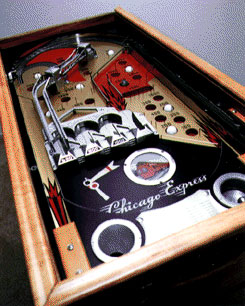
First Look
This game has a nice wood finish and is 21 inches wide, 41 inches deep, and 42 inches tall. It appears as a box on spindly legs. It has the expected coin slide and twin plungers for ball lift and shooter.
Looking into the box at the play field, the first thing you notice is the ramps. Ramps in a 1930's game! The bottom of the play field is dominated by a train locomotive and a train semaphore. There is a large contraption above it that seems to pass the ball from position to position and has three positions to hold a ball.
Scattered all over the play field are 23 holes to trap the ball. The scores are indicated under each hole and seem to be grouped according to their magnitude. Large values are in one area in the upper right, smaller values in other areas.
The colors on the play field are bright. In one version they are gold and red with black highlights. In another, the colors are blue and orange with black highlights. This latter version has one less hole. The polished castings and chrome add much flash to the game and give it a definite three dimensional effect.
A first time player might wonder at the apparent lack of flippers, solenoids or pop bumpers, and will wonder especially how the ball can get up onto the railroads.
Style
The style of the game is post art deco. This game has some of the colors and flavor of art deco but none of the finer embellishments. The fine lines, multiple colors, and curves are missing. The style contains more chrome and metal, with the girders of the bridges and the arches shining brightly.

Layout
The layout consists of areas of interest. At the top of the play field are the entrances to the elevated railroads. The two entrances appear as towers. The black markings on the play field indicate the desired path from the rebound rubber into the towers.
Scattered around the towers at the top of the play field are a series of holes and pins. The value of the holes varies depending on the difficulty of reaching them. There are clusters of holes with similar values, the more difficult to reach are higher. The values start at 300 and progress up to 500 with a single difficult to reach hole having a value of 1000.
The railroad leading from the towers arrives at a progressive scoring area. This is a series of stations of increasing value, where the ball gets passed from left to right. Their values are 600, 800, and 1000. After passing through three stations the ball is projected to a high scoring area in the upper right.
This area in the upper right is only accessible to a ball having passed through the progressive area. The holes in this area score between 1500 and 5000 points. There is also an obscure way of reaching these holes mentioned below.
There are two back doors, areas where the ball manages to travel to the bottom left and right sides of the play field. It is easy to reach the bottom left as the ball misses the various holes. It is more difficult to reach the bottom right as the ball must miss all the holes in the upper play field, skip past the progressive stations, and miss additional holes in the bottom right area. These latter holes range from 100 to 400, with one tantalizing hole worth 1000.
However, should the ball get to the bottom, the ball is propelled up the field again by a solenoid. In the case of the left side, the ball can go as far as the top of the field. In the case of the right side, the ball could be projected to the high scoring area.
Below the progressive stations is a logo containing the game's theme. There is a semaphore with a light, a locomotive image reverse painted on glass and back lit, and the name Chicago Express. This area is large and not used for play.
There are ten white china balls. There is also one green china ball, which scores double.
At the bottom of the game are two viewing holes, one to see the last coin played, preventing a slug from being used. The hole on the right has a pedestal and ball to indicate excessive shaking or tilting. Between the two viewing holes is an area used in one case for a score card and in the older version for a sunset casting with the manufacturer's name.

The score card has two sections. The first indicates play:
To Operate 1. Insert Coin in Slot. 2. Push Slot all the way in. 3. Hold it long enough to permit all balls to drop down. 4. Pull Slot all the way back and shoot for track elevators. 5. When tilter ball is off the post, machine will not operate.
The other half of the card indicates skill points based on the score. This could be interpreted as the payout values, if the establishment paid off!
Score 14,500 or over 2 Skill Points 16,500 or over 3 Skill Points 18,000 or over 4 Skill Points 20,000 or over 5 Skill Points 22,000 or over 10 Skill Points 24,000 or over 20 Skill Points Odd Color Ball Counts Double
Game Play
There are no flippers so the player must make the shot carefully and be content to nudge. A coin is inserted in the coin slide and the slide is pushed in carefully. The game drops all the balls through the now open holes into the bottom of the game, the pedestal retracts allowing the tilt ball to roll on top, and the slide is retracted.
The game slowly recovers the score holes and raises the pedestal, see later note. The player then pushes the ball lift mechanism, the bottom push rod. A ball is lifted in front of the shooter and the player carefully makes the shot and starts nudging.

Control
There is little control of where the ball goes as the tilt is very sensitive. However the balls are made of china and more easily deflected by nudging. They are much lighter than the currently used steel balls. A typical game goes like this:
You shoot for one of the elevators. You may miss and then you should nudge the ball so it reaches one of the bottom corners. There the ball will be pushed back up the field and you get a second chance, or better it will be propelled into the high scoring area.
But in general, you shoot for the elevators. The ball enters the elevator and gets propelled along the raised tracks to the first progressive scoring station. You shoot the second ball into the elevator and immediately the previous ball in the first scoring station gets bumped over to the second progressive station, making room for the ball that just entered the elevator. The ball in the elevator is then moved to the first progressive station. And repeat.
The ball bumped into the third station will be propelled into the high scoring area and bump around into a high scoring hole.
Goals
Obviously the object is to get the balls to land in the higher scoring holes and to get the green ball into the highest scoring hole. So the green ball needs to show up early and get passed into the elevators, progress through the stations, and get pushed into the high scoring area in the upper right.
Scoring
Scoring will test your ability to add. You must add the values of all the scores next to occupied holes. There is one green ball and the value of the hole occupied by the green ball is doubled.
Shoot all ten of your balls, total your score, and collect your winnings.
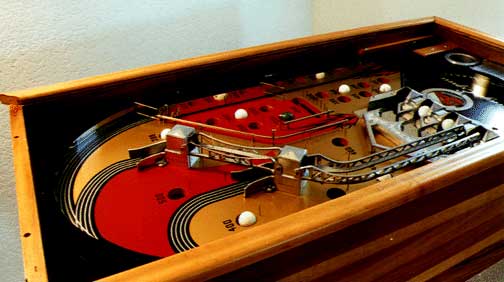
Artistry
The game is art deco in appearance. There are bright colors and the artistry of the locomotive is modern, almost looking like a modern high speed bullet train.
The elevators and train tracks are castings and are embellished with girders and railings. The progressive station areas have arches and grids as in art deco style.
The theme is understated and indicated only by the picture at the bottom, the semaphore next to it and the name under the picture.
Cabinet
The cabinet is in light wood with contrasting veneer in the sides. It has a natural finish and does not appear to be stained. The legs are similar to bingo legs and are attached with two bolts through the side rather than the expected 45 degree angle. There are two doors, one in front and the other in back. The one in front is not flush but projects slightly, and provides access to the coin box.
The door in the rear is flush and provides access to the battery and the bolts holding down the rear molding. The glass is removed by lifting the rear molding and sliding out the glass. Then the play field can be unscrewed from the cabinet and lifted out.

Mechanical
The game is not complex but does have some interesting features. There are indications it was well thought out and designed to last. There is quality through out, with as many castings underneath the game as there are above.
Nine of the balls are white china and one is a solid green color, totaling ten for a nickel.
Starting with the ball lift mechanism, there is the expected ball lock out when the coin slide is pushed in. The reset board, which uncovers the holes to allow the balls to return to the feed tray, is extensive and is a single piece. It is activated by the slide mechanism and has a lever that lowers the pedestal for the tilt indicator.
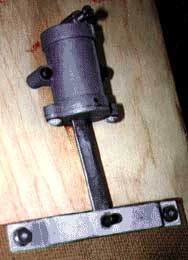
And interesting feature, alluded to above, is the shock absorber attached to the reset board. There is a pneumatic damper which slows the return to play position, also slowing the raising of the tilt pedestal. This causes the game to reset gently, in spite of the player quickly pulling back the coin slide.
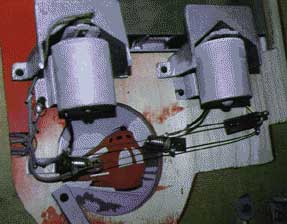
Solenoids
There are two types of solenoids, elevator lifts and pushers. The elevator lifts are narrow coils with a lift rod extending completely through the winding. The core is pulled into the winding, causing a rod and platform to lift the ball in the elevator. The top of the elevator tower is curved to direct the ball along the tracks to the next station. There are two sets of contacts in each elevator, one to progress the balls in the lower stations, and the second to activate the elevator.
The second type of solenoid is really just an electromagnet attracting a plate. The plate is the bottom part of a lever and the lever pushes the ball away. There are two solenoids in the bottom left and right corners of the play field and two in the progressive stations. One moves the balls to their next positions and the other shoots the ball to the higher scoring region.
The lower solenoids and the solenoid that propels the last station ball into the high scoring area are activated by a ball arriving at that location.
There are only six total solenoids as only one is used to progress the balls in the first three stations.
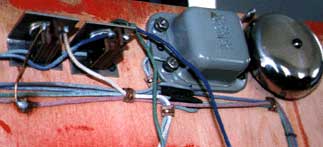
Bell and Lights
There is a bell and it announces the propelling of a ball into the higher scoring area and it is activated at the same time the solenoid at the last progressive station is activated. The bell appears to be the normal mass produced door bell style, with a coil, interrupter enclosed in a stamped metal cover and an external clapper and bell.
The lights are activated any time a solenoid is activated.
Engineering
The castings around the pusher solenoids have points, thus directing the ball around the solenoids during ball return. There are wooden cutouts also directing the balls around holes at return time and the top points of these wooden cutouts have nails protecting the point, in the off chance the ball will balance there.
The leaf switches in the elevators are not, however, engineered well. There are two sets there, one to activate the progressive station, making room for the coming ball, and one to activate the elevator. The adjustment is critical, making sure one happens before the other and making sure the closure is long enough to propel the ball to where it needs to go.
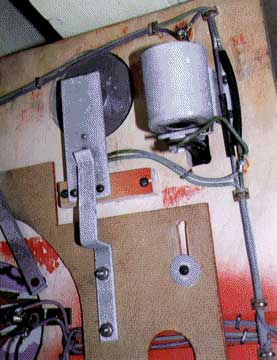
Wiring
The wire used in this game is rubber coated stranded copper and attached underneath the play field with paper insulated staples. There was no fabric coated wire in this game.
Friction tape was used to cover some of the joins where wiring split to go to different locations. In other areas, solder was used to attach two wires, as were a solenoid lead is attached to the main wiring. Burn marks in the wood at the join indicate this was done at assembly.
There is a leaf switch under the pedestal, requiring the weight of the tilt ball to close the switch. It controls only the solenoid propelling the ball at the last progressive stage.
The game has a progressive adjustment, allowing the operator to increase or decrease the score. The switch controls the shifting of the balls in the progressive section. Turned on the entry of a ball into the first track will shift the balls. Then the ball is shoved to the next track and again the balls in the progressive section are shifted over. This also leaves a blank spot in the shift if the stimulating ball first enters the tracks at the top of the field. The switch turned off will cause progressive balls to shift only on the ball entering the second set of tracks leading to the progressive area.
There is also a switch to turn off the game.
Modifications
There were no visible operator modifications.
Innovation
Some features were unique for the day. The tilter mechanism was just invented, although it is doubtful Chicago Express was first to use it. The electrical contact under the pedestal, sensing the fact the game was nudged too much, may have been a first.
The pneumatic damper on the play field return added a soft touch to the reset.
The elevated tracks were novel and provide much of the initial attraction.
And the back lit, reverse painted glass may have inspired the back glass of the future.
Patents
No patent numbers were found. A patent search for patents attributed to Daval will be made.

(Note this is a different version, with blue and orange instead of red and gold.)
Restoration
Two games provided the information for this review. One is owned by Don Wright of Roseville, California, USA and the other by the author, Michael Sands, Sunnyvale, California, USA.
Only Don's has been restored. Little work was required to return it to playable condition. Don had converted the game to use a power supply instead of batteries. The power supply leads were reinstalled with correct strain relief.
The play field was removed and cleaned.
The coin slide was cleaned and adjusted and then toothpicks installed to allow for free play. The play field was cleaned and paste wax applied. Several of the pins were straightened and polished. The tilt mechanism was polished and the switch at the bottom of the pedestal adjusted. It had been bent to always make contact.
The electrical problem was a loose wire on a solenoid, causing increased resistance and poor ball movement in the elevators. One of the leads was broken just as it exits the winding and this was not correctly fixed as a rewinding of the coil would be required. Also the bell was stuck on resulting in poor ball movement into the high scoring area and no bell sound as it acted like a short.
The rubber on the ball feed and shooter was replaced with plumbing gasket material
Finally the contacts in the elevators were adjusted. This is not an easy job as the adjustment is absolutely critical for good play. If the contacts are too close together, the ball will close them only momentarily, and the progressive solenoids will not energize long enough to pass the ball. If the contacts are too far apart, the ball will not have sufficient momentum to close them and the ball will sit in the bottom of the tower.
Restoration took 21.5 hours.
Tuning
The operator instructions were printed on paper and attached to the inside of the back door with brads. English and capitals are theirs.
Chicago Express Instructions to Operators! (1) When setting up machine on location, be sure to put the steel TILTER BALL on top of the tilter post thus completing the electrical circuit. (2) Do not disturb the wiring or the contact points unless you positively have to. Keep machine CLEAN INSIDE, as well as outside. A speck of dust at or near a contact point if blown out or cleaned out in time will prevent 99% of any supposed electrical trouble. (3) To give playing field the proper pitch to allow balls to roll down rapidly, unscrew the leg adjusters on the rear legs about a 1/2 inch lower than those in the front legs. DAVAL MFG. CO. Chicago, U.S.A. 200 So. Peoria St. Inspected by No._____________
(It appears as if the number hand written in the blank is a sideways eight.)
Numbers
Mine appears to be older with serial numbers stamped into the bottom front edge of the cabinet and an identical number on the back door in pencil, 18803.
Don's machine had a 21897A stamped into the wood on the bottom front edge of the cabinet and a 21897 in pencil on the inside of the front door. There was also an 83 in pencil on the bottom of the cabinet, and may have been the inspector's number, see above.
Also in Don's machine, on the underneath part of the play field, near the coin slide, are the numbers 91-8 and the word Mendy and a squiggle.
References
Bueschel, D. Pinball 1
Mueting, D and Hawkins, R Pinball Collectors Resource
Schlenker, J. Pinball Trader July 1990 (page 34)
Sharpe, R. Pinball ! (page 31)
